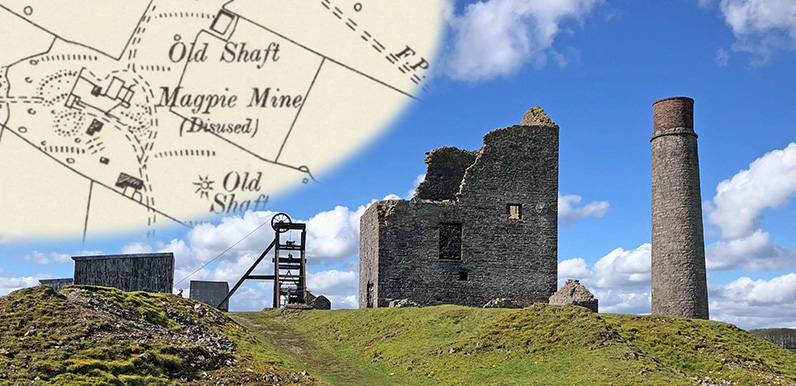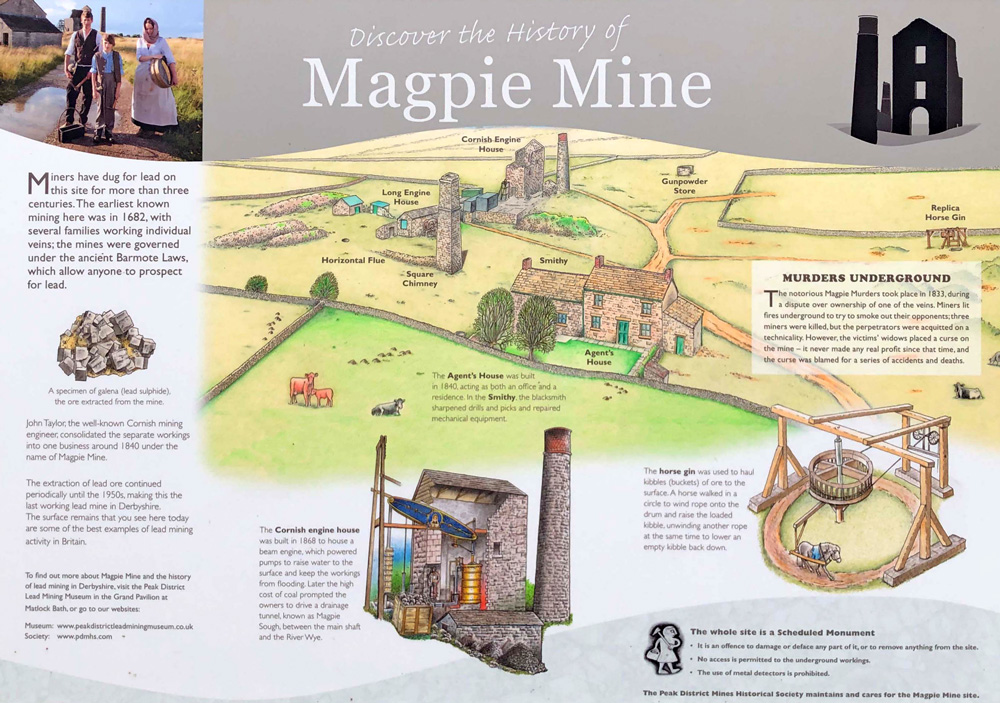Above: Maps from the 1890s show Magpie Mine as ‘Disued’. But it wouldn’t finally close until 1953.
Lying just south of the small village of Sheldon, the ruins of Magpie Mine can be seen from quite a distance. The site is on public footpaths and easily accessible (see Ashford walk).
The earliest records date back to 1740 when there were about a dozen small mines extracting the precious galena ore from which lead is produced. But as the miners dug deeper, water flooding the workings became an increasing problem.
In 1824 a Newcomen steam engine was installed above the main shaft to pump water to the surface. This enabled miners to break all previous records in 1827, producing some 800 tons of lead.
The mine went through many changes of ownership and fortune over the years, with profits increasing in time of war when lead shot was in great demand. But then dropping in the face of competition from mines that could produce it far easier and cheaper, particularly from abroad.
Above: This display board behind the square chimney provides a good description of the various buildings, as well as details of the infamous ‘Magpie Murders’ (click to enlarge)…
The notorious Magpie Murders took place in 1833, during a dispute over the ownership of one of the veins. Miners lit fires underground to try to smoke out their opponents; three miners were killed, but the miners were acquitted on a technicality. However, the victims’ widows placed a curse on the mine – it never made any profits since that time, and the curse was blamed for a series of accidents and deaths.
Disputes between two groups of miners – those working the Magpie and Redsoll shafts – had broken out soon after the pump was installed when both laid claim to a newly discovered vein of ore.
Finders keepers
All mines were governed by a strict set of rules, and the most important was that the first miners to find a new seam could claim ownership. Both groups seem to have discovered the vein at the same time, but Redsoll argued that they had been working the area for decades. Whereas Magpie only laid their claim after one day’s work.
A tribunal found in favour of Redsoll, but this was reversed on appeal as only Magpie had written proof of their legal rights. By 1831 both sides were engaged in various acts of violence and had sentries standing guard on the surface and underground.
One commonly used method of intimidation was to light underground-fires of tar and straw to drive the other side out. In 1833 the inevitable happened and three Redsoll miners lost their lives. 24 Magpie miners argued that they were acting in self-defence. And since both sides had engaged in similar tactics, and it was impossible to say who lit the fires, they were acquitted.
Derbyshire’s last lead mine
A succession of increasingly large steam-driven pumps failed to prevent the workings from flooding, and in 1873 it was decided to tunnel a sough to drain water into the River Wye near Ashford; a distance of well over a mile.
The eight-year project proved succesful, but at £18,000 the cost was ruinously expensive, especially as the price of lead had dropped considerably. Magpie Mine officially closed in 1883, although it reopened and closed a number of times over the following years until finally giving up the fight in 1953, making it the last lead mine in Derbyshire.


